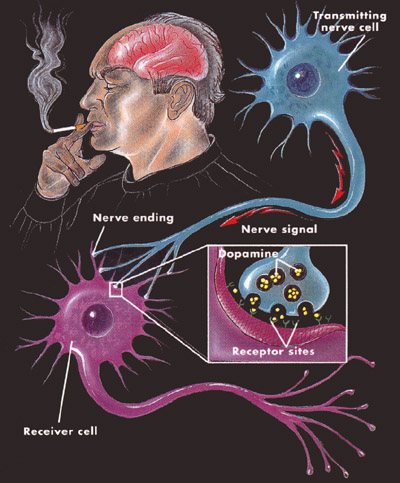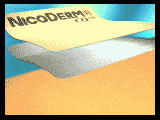This news item was created by students Diana Dang, Monique Petersen, Sara Stacy, and Mya Cross as part of their Chemistry 212 Collaborative Group Activities in WS00 under the guidance of
Prof. Rainer Glaser.
Glaser's "Chemistry is in the News"
To Accompany Wade Organic Chemistry 4/e.
Chapter 19.
Amines
For each of the following questions, please refer to the following
article:
NICOTINE IMPROVES SOME SYMPTONS OF PARKINSON'S DISEASE
by Dan Ferber, PhD (WebMD, February 21, 2000)
Editorial Comments

|
|
How smoking affects dopamine levels. Click to enlarge. © SFN.org
|
|
A highly toxic alkaloid, nicotine is one of the oldest drugs known to man and one of the most addictive. It has long been the prime target of anti-drug campaigns as the killer tobacco, but now, a slew of recent studies has uncovered that perhaps there is a good side to nicotine. Researchers have discovered rather ironically that the pathway by which nicotine becomes addictive may be the key to treating Parkinson's Disease, Alzheimer's Disease, and Tourette Syndrome--neurological disorders associated with the neurotransmitters acetylcholine and dopamine.
The human body has natural receptors for nicotine in the brain, hence the reason why addiction is so quick and so solid. Coincidentally, these receptors are also stimulated acetylcholine, an important neurotransmitter that carries chemical signals between nerve cells.
Stimulated by nicotine acting as acetylcholine, the nicotinic acetylcholine receptors may be kept active and functioning, promoting the health and life of nerve cells. Indirectly, nicotine also regulates several other chemicals in the body, including dopamine, which plays an impressive role in mental health.
While Parkinson's and Alzheimer's Disease result from a decline in acetylcholine receptors, an abnormal level of dopamine brings on Tourette Syndrome. Given the properties of nicotine on the human body, it is not surprising that researchers have shown nicotine and related compounds to be an effective treatment for Parkinson's, Alzheimer's, and Tourette. Although the studies are yet to be published later this year, collected data shows much promise. So much, in fact, that many participants in the studies continued to use nicotine even after the research was completed.
This is certainly not a call to take up smoking, and even with other forms of nicotine in patches and gums, addiction is still one of many serious side effects. While alternatives to nicotine such as mecamylamine and ABT-418 are being tested, the long-term effects, good or bad, are questionable. Still, this may be nicotine's chance to play the good guy and turn over its infamous reputation as tobacco.
|

|
|
Animation: Nicotine stimulating nicotinic acetylcholine receptors, opening ion channels and allowing the spread of action potential. Click to watch. Requires Quicktime. © Neuroguide
|

|
|
An artist rendition of a nicotinic acetylcholine receptor. Click to enlarge. © SDSC.edu
|
|
Pertinent Text References
Chapter 19. Amines.
Questions
Question 1:
List the characteristics of Tourette Syndrome, Parkinson's Disease, and Alzheimer's Disease. How do nicotine and the related compounds help correct these symptoms?
Answer: Tourette Syndrome is characterized by repeated and involuntary body movements (tics) and uncontrollable vocal sounds. Parkinson's Disease is characterized by tremors, rigidity, slowed automatic movement, and postural instability. Alzheimer's Disease destroys the ability to reason, remember, imagine, and learn. In the case of Tourette Syndrome, nicotine normalizes the dopamine level. With Parkinson's and Alzheimer's, nicotine keeps the acetylcholine receptors functioning.
.
Question 2:
Use Chemfinder to draw the structure of nicotine and give the IUPAC name. How many known isomers exist and which form is the active form?
Answer: The IUPAC name of nicotine is (S)-3-(1-methyl-2-pyrrolidinyl) pyridine, and there are two isomers of nicotine, (R)-(+)-nicotine and (S)-(-)-nicotine, which are enantiomers. The (S)-(-)-nicotine is the active form found in cigarettes.

Question 3:
The IUPAC structure of ABT-418 is (S)-3-methyl-5-(1-methyl-2-pyrrolidinyl) isoxazole. Draw the structure.
Answer:

Question 4:
Over an extended period of time, is nicotine effective for the treatment of such neurological diseases? (Hint: Can a resistance be built to such drugs?)
Answer: Smokers have a tendency to build a tolerance to nicotine, requiring more and more over an extended period of time to acquire the same high. Thus, it is plausible that patient using nicotine as treatment may also need to increase dosage for the same effectiveness.
Question 5:
What are the pros and cons of nicotine as a treatment for neurological diseases? Are there any known drugs that have similar effects without the negative implications of nicotine?
Answer: Nicotine is relatively inexpensive, readily available, and is a simple treatment. Unfortunately, the cons of nicotine include addiction, increased blood pressure, heart problem, and is lethal at high levels. In some cases, nicotine may cause tremors. Mecamylamine and ABT-418 are known substitutes for nicotine with little known side effects. Mecamylamine has even lowered blood pressure in recent studies. However, they are both still under analysis by the FDA.
Question 6:
Do the benefits of treating a debilitating neurological disorder such as Tourette syndrome, Parkinson's, or Alzheimer's with an addictive stimulant like nicotine outweigh the adverse effects from the drug? Explain.





